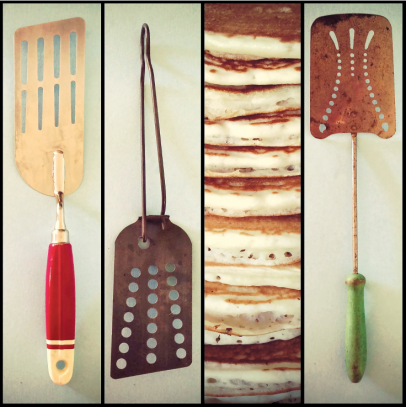A Quirky Kitchen
My quirky obsession with antique kitchen utensils started as my husband, Gerald, and I began to travel inexpensively (well, cheaply) as newlyweds. We hunted and haunted little remote antique shops in California’s Gold Country looking for gifts for my mother, an artist and interior designer. I am sure I felt less guilt about buying things—since they were gifts for my mother—but I don’t even remember if she liked them.
Actually, it all really began in my grandmother McKelligon’s kitchen in Berkeley, where I considered it a privilege to sit in her breakfast nook and quietly shell peas while she listened to her “programs” (soap operas) on the radio. I never got to chop anything, but occasionally walked the three blocks to Solano Avenue alone to pick up cans of sweet petit pois. Of course, the store owners had orders to call her when I arrived and again when I left for home, which took a while if they slipped me a free Tootsie Roll.
Note that our grandmothers never had to go to the gym. They expended a lot more energy than we do in actually growing food, walking to the market to buy what food they did not grow themselves, and even in the kitchen. And, yes, my railroad executive grandfather kept chickens in the backyard in Berkeley.
Together, my mother and I bought a hotshot Cuisinart in the early ’80s and, between us, I think we used it once. That old all-purpose knife I bought in San Francisco’s North Beach decades ago seemed to cut and chop everything I needed, and it still does. And I still make coffee in my decades-old glass Melitta drip pot.
In fact, everything in my kitchen is old. And why not?
It was the Cuisinart that made me wonder if we really need all this new stuff. Nearly all the hottest new kitchen gadgets and utensils were invented to make cooking easier and easier, and faster and faster. We all know people with kitchens full of the latest model of everything although they rarely cook, but what if you actually like being in the kitchen?
After my mother passed away, I quickly retrieved all the utensils I had ever given her. At that time there weren’t enough to hang on my walls, as many do today. They simply went into my kitchen drawers so I could use them, and I still do.
I don’t know when I have ever bought a new gadget to cook with myself. In fact, when my Le Creuset teakettle burned up recently, I mourned it and the fact that I might have to buy a new one. But wait—I went out into the garage, or rather my “museum,” and chose a teakettle from my collection.
But, wait again—this teakettle matches all of my mother’s 50-year-old Revere Ware that hangs from an iron pot rack over an ancient baker’s table in the middle of my kitchen.
My father’s cast-iron frying pan that he took on trout fishing trips years ago also hangs from that rack, is thicker than those made today and carries with it all those fabulous memories he and I shared in the relative wilderness of California.
Since my obsession travels with me, I have found unique utensils and tins from home kitchens in England, Scotland, France, Canada and 10 other countries, as well as close to home. All of them come enriched with stories, cherished pieces of family kitchens, and reflect what was going on culturally, socially, agriculturally and economically at the time of their creation—some as early as the 1800s.
The most fun result of my collection, wherever parts of it are shown, is listening to the outpouring of memories about the utensils used by the viewers’ own mothers, fathers, grandmothers, grandfathers, aunts and uncles—and, often, their own first knuckle-grating experiences.
Enjoy Kitchen Memories: The Kathleen Thompson Hill Culinary Collection and Delicious Images: Art and Food—Paintings and Works on Paper by Wayne Theibaud and Joseph Goldyne, September 7–December 1, 2013, at the Sonoma Valley Museum of Art; SVMA.org; 707.939.7862.





